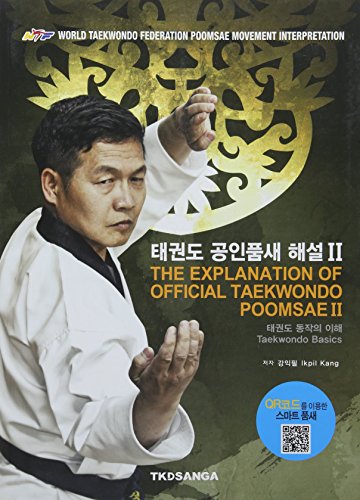Taekwondo Basics
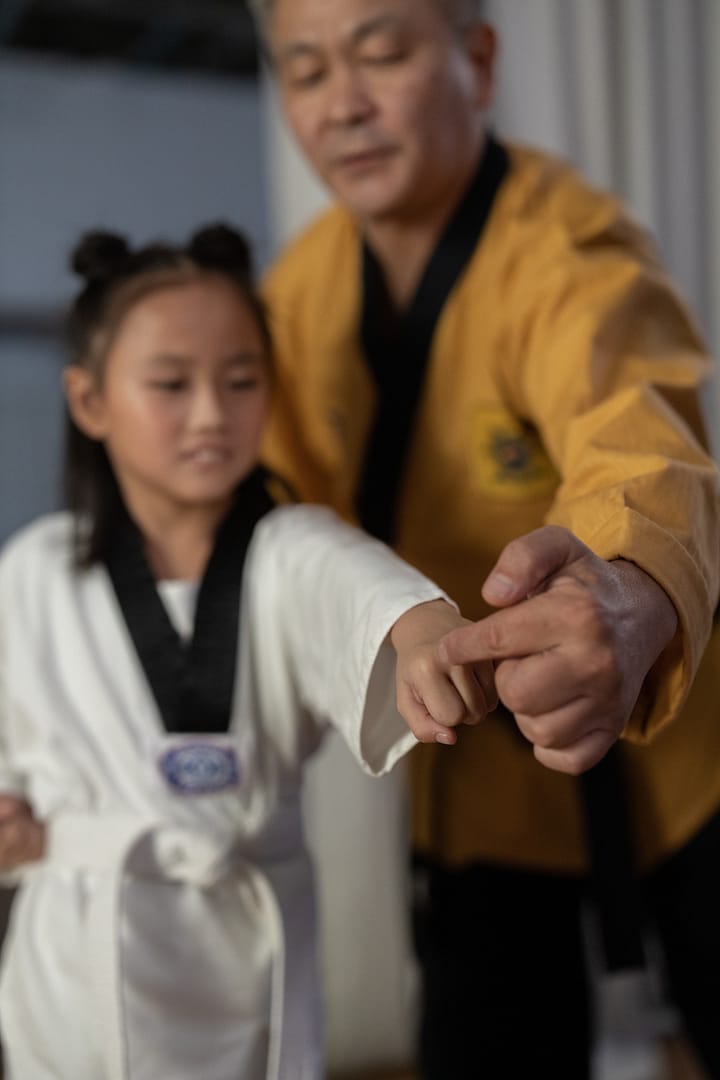
Mastering the Fundamentals: A Comprehensive Guide to Taekwondo Basics
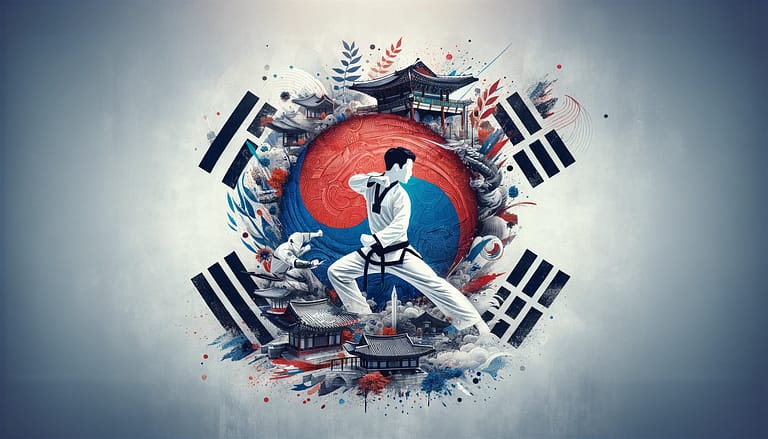
Table of Contents
What is Taekwondo?
Taekwondo is a Korean martial art that combines kickboxing, self-defence and athletic exercise. It has its roots in various Korean forms of martial arts that date back over 2,000 years and is based on the principles of breaking or attacking with the foot (“Tae”) and fist (“Kwon”). “Taekwondo” translates to “The way of the foot and the fist.” As a sport, Taekwondo is practised by over 70 million people worldwide and is governed by the World Taekwondo based in South Korea.
The sport consists of Poomsae, sets of attacking and defensive movements that include punching, kicking, blocking, and different stances. Poomsae forms are essential to Taekwondo promotion, and practitioners must demonstrate a good understanding of them before they can advance to the next grade. There are two main types of Taekwondo: traditional and modern.
Traditional Taekwondo is also known as Korean martial art or karate and is based on techniques developed in Korea over 500 years ago. It is usually practised using a short stick (sigi) or a long one (chook), and some self-defence classes are typically required before attempting to use them.
Visit our website for more information about Taekwondo, including its history, tenets, techniques, etc.
Introduction to Taekwondo: The Korean Martial Art
Taekwondo is a Korean martial art that combines both self-defence and sports elements. It is known for its powerful and precise kicks and focus on mental and physical discipline. If you’re new to Taekwondo, this guide will cover the basic commands and some of the essential elements you’ll need to get started.
Lesson 1: Essential Elements of Taekwondo
Before diving into specific techniques, it’s important to understand the basic elements of Taekwondo. The essential elements include:
Stances
The foundation of any martial art is a strong stance. There are several different stances in Taekwondo, each with its purpose.
Blocks
Blocking is a crucial part of self-defence in Taekwondo. There are several different blocks you’ll need to master to defend yourself effectively.
Kicks
Kicks are the hallmark of Taekwondo and are used to strike an opponent from a distance.
Punches
While Taekwondo is primarily known for its kicks, punches also play a role in self-defence and are used to strike an opponent at close range.
Taekwondo: A Comprehensive Guide for Beginners
The five rules and tenets of Taekwondo, while similar in spirit, may vary in terminology depending on the style of Taekwondo practised. Both sets represent the core values and principles that practitioners are expected to follow and embody in their daily lives.
The Five Tenets of Taekwondo:
- Courtesy (Ye Ui): Demonstrating respect for others, showing politeness, and observing proper etiquette.
- Integrity (Yom Chi): Adhering to moral principles, being honest, and upholding strong ethical values.
- Perseverance (In Nae): Demonstrating determination and steadfastness in overcoming challenges.
- Self-Control (Guk Gi): Exercising control over one’s behaviour, emotions, and actions.
- Indomitable Spirit (Baekjul Boolgool): Possessing unbreakable fortitude and bravery, especially in the face of adversity.
In some Taekwondo styles, the five rules are referred to as Etiquette, Modesty, Perseverance, Self-control, and Indomitable Spirit. In contrast, other styles may refer to them as Respect, Discipline, Perseverance, Honor, and Courage. These terminological differences reflect the cultural and historical backgrounds of various Taekwondo styles, as well as their specific teaching philosophies and emphases.
For instance, traditional Korean Taekwondo styles might emphasize the tenets of Etiquette, Modesty, Perseverance, Self-control, and Indomitable Spirit more, as they resonate with the traditional values and culture of Korea. Conversely, Western Taekwondo styles might focus on the rules of Respect, Discipline, Perseverance, Honor, and Courage, aligning more closely with Western cultural values and norms.
Regardless of the specific terms used, the five rules or tenets of Taekwondo serve as guiding principles for practitioners. They promote personal development, instil discipline, foster respect for others, and cultivate a strong, indomitable spirit.
The Five Rules of Taekwondo vs the Five Tenets of Taekwondo
The five rules and tenets of Taekwondo are similar in meaning but may vary in terminology depending on the style of Taekwondo being practised. The five rules and tenets are the core values and principles that Taekwondo practitioners must follow and embody in their daily lives.
- Courtesy (Ye Ui): Demonstrating respect for others, showing politeness, and observing proper etiquette.
- Integrity (Yom Chi): Adhering to moral principles, being honest, and having strong ethical values.
- Perseverance (In Nae): Showing determination and steadfastness in overcoming challenges.
- Self-Control (Guk Gi): Exercising control over one’s behaviour, emotions, and actions.
- Indomitable Spirit (Baekjul Boolgool): Possessing unbreakable fortitude and bravery, especially in the face of adversity.
In some styles of Taekwondo, the five rules are referred to as Etiquette, Modesty, Perseverance, Self-control, and Indomitable spirit. In contrast, in others, they are referred to as Respect, Discipline, Perseverance, Honor, and Courage. These different terminologies reflect the cultural and historical background of the different styles of Taekwondo, as well as their specific teaching philosophy and emphasis.
For example, in some traditional Korean Taekwondo styles, the five tenets of Etiquette, Modesty, Perseverance, Self-control, and Indomitable spirit may be emphasized more as they reflect the traditional values and culture of Korea. On the other hand, in some Western Taekwondo styles, the five rules of Respect, Discipline, Perseverance, Honor, and Courage may be emphasized as they are more applicable and relatable to Western cultures and values.
Regardless of the terminology used, Taekwondo’s five rules or tenets guide the practitioner towards personal development, discipline, and respect for others and help them cultivate a strong and indomitable spirit.
Can I Teach Myself Taekwondo?
While it is possible to learn some basic taekwondo techniques on your own, it is not recommended for beginners. The art of Taekwondo requires proper technique, and it can be challenging to develop without proper guidance and feedback from an experienced instructor. An experienced instructor can help you avoid bad habits, provide feedback on your technique, and ensure that you learn safely and effectively.
Is Taekwondo Easy for Beginners?
Taekwondo can be a challenging martial art for beginners, but it can also be highly rewarding. The key to success in Taekwondo is persistence, perseverance, and patience. With the right attitude and dedication, anyone can learn the basics of Taekwondo and progress to advanced techniques.

The Six Basic Kicks in Taekwondo
Front Kick – Ap Chagi
A front kick is a straightforward and straightforward kick delivered to the front of the opponent’s body.
Kick ap chagi is a front kick in Taekwondo. This kick is performed by extending the front leg while keeping the back leg stationary. It’s essential to maintain a strong stance throughout the kick and to keep the knee and ankle of the kicking leg straight.
Roundhouse Kick – Dollyeo Chagi
The roundhouse kick is a powerful and versatile kick delivered in a circular motion to the side of the opponent’s body.
Round kick dollyeo chagi is a circular kick in Taekwondo. This kick is performed by pivoting on the back foot and extending the front leg in a circular motion. It’s essential to keep the ankle of the kicking leg straight and to generate power from the hip.
Side Kick – Yop Chagi
A side kick is a fast and powerful kick that is delivered to the side of the opponent’s body.
Back Kick – Dwi Chagi
The back kick is a fast and powerful kick delivered to the back of the opponent’s body.
Hook Kick – Bitureo Chagi
A hook kick is a fast and powerful kick delivered with a circular motion to the side of the opponent’s body.
Axe Kick – Naeryeo Chagi
An axe kick is a powerful kick delivered from a high position to the side of the opponent’s body.
In conclusion
Taekwondo is a fun and challenging martial art that can help you to develop discipline, respect, courage, and perseverance. Whether you are a beginner or an experienced practitioner, Taekwondo has something for everyone. With the right attitude and dedication, anyone can learn the basics of Taekwondo.
What is the difference between World Taekwondo and International Taekwondo Federation?
Taekwondo is a Korean martial art known for its fast, powerful kicks and a focus on discipline and respect. It has two main styles: World Taekwondo (WT) and International Taekwondo Federation (ITF). The WT style is widely recognized by the International Olympic Committee and is the style practised in the Olympic Games. Most US taekwondo schools also follow the WT. The ITF style, founded by General Choi Hong Hi, emphasizes self-defence, traditional martial arts techniques such as forms, sparring, and breaking, and has more traditional uniforms.
The scoring system in sparring differs between the two styles, with WT awarding points for strikes to scoring areas and ITF for strikes, kicks, throws and takedowns. The WT style has eight forms (Poomsae), while ITF has more forms divided into sets for different belt levels. The WT style focuses more on Olympic-style sparring, while ITF focuses more on traditional martial arts competition. The choice between styles depends on individual goals and preferences.

The Five Tenets
The five tenets of Taekwondo are fundamental principles that all martial artists and practitioners should uphold. These tenets serve as a code of ethics that guides a student’s behaviour and character development inside and outside the dojang.
The first tenet is etiquette, which refers to the proper way of conducting oneself in any situation. Students should learn to show respect and politeness towards others, especially their seniors and instructors.
Modesty is the second tenet, and it emphasizes the importance of humility. Martial artists must avoid showing off or boasting about their skills, as this goes against the principles of Taekwondo.
Perseverance is the third tenet, which refers to the ability to keep trying and pushing oneself even when faced with challenges or obstacles. This tenet teaches students to be patient and resilient in adversity.
Self-control is the fourth tenet, the ability to control one’s thoughts, emotions, and actions. Practising self-control allows a martial artist to maintain composure and make better decisions, even in difficult situations.
The fifth and final tenet is the indomitable spirit, which refers to the unwavering determination never to give up or be defeated, no matter how difficult the situation may seem. This tenet encourages students to maintain a positive attitude, even in adversity.
In summary, the five tenets of Taekwondo are essential values that guide a student’s behaviour and character development. Practising these principles regularly can help individuals become better martial artists and, more importantly, better individuals in their daily lives.
In short:
- Etiquette – Know how to behave.
- Modesty – Never show off.
- Perseverance – Keep on trying.
- Self-control – Ability to control your behaviour and actions
- Indomitable spirit – Never give up.
The five tenets guide a student’s behaviour – inside and outside the dojang. One’s character is built on these values, so the students must consider applying these to their daily lives – everything they do and how they interact with others.
The Grading Syllabus
The Taekwondo Grading Syllabus is a set of requirements that students must meet to progress through the ranks of Taekwondo. It includes various techniques such as kicks, strikes, blocks, and forms, as well as physical fitness and sparring requirements. Each grade has specific requirements, with higher ranks requiring more advanced techniques and greater proficiency in Taekwondo. Grading tests are typically conducted by a panel of senior instructors and are designed to assess the student’s knowledge, skills, and overall ability to perform at their current rank level. Successful completion of each grading test leads to promotion to the next belt rank.
You can view the Taekwondo4Fitness/ITO Grading Syllabus as an initial version on my webpage.
Korean Terminology

Korean taekwondo terminology is an essential component of Taekwondo, as it is the language used to describe techniques, movements, and commands during training and competitions. Learning Korean taekwondo terminology is an integral part of the Taekwondo journey, as it enables students to communicate effectively with their instructors and fellow students and understand the principles and philosophy of the art.
The Korean taekwondo terminology used in Taekwondo includes words for different types of kicks, punches, blocks, and strikes, as well as for stances and movements. Specific Korean terms are also used to describe various aspects of training, such as patterns, sparring, and breaking.
To help students learn Korean taekwondo terminology, many Taekwondo schools use various teaching methods, including repetition, visual aids, and practical application. Students often start with learning basic Korean terms and gradually progress to more advanced terminology as they advance in rank and skill.
In addition to being an integral part of Taekwondo training, learning Korean taekwondo terminology can also be a rewarding experience that helps students develop a deeper understanding of the art and its cultural origins. By understanding the meaning behind each term and its connection to the overall philosophy of Taekwondo, students can gain a greater appreciation for the art and its significance.
Please check out my boards on Pinterest. They include pins for Korean Terminology, body parts, how to tie a belt, etc.
Korean Terminology for Taekwondo:
- Taekwondo (태권도) – the name of the martial art
- Dojang (도장) – the training hall or gymnasium
- Dobok (도복) – the uniform worn by taekwondo practitioners
- Sabum (사범) – instructor or master
- Kup (급) – rank or belt level
- Kyorugi (교루기) – sparring or fighting
- 기본동작 (Gibon Dongjak) – Basic movements or techniques.
- 품새 (Poomsae) – A formal series of movements or patterns.
- 겨루기 (Gyeorugi) – Sparring or fighting.
- 태극기 (Taegukgi) – The national flag of South Korea.
Vocabulary for Basic Taekwondo Techniques:
- Chagi (차기) – kick
- Ap Chagi (앞 차기) – front kick
- Yop Chagi (옆 차기) – side kick
- Dollyo Chagi (돌려 차기) – roundhouse kick
- Bandae Dollyo Chagi (반대 돌려 차기) – reverse roundhouse kick
- Tollyo Chagi (톨레 차기) – axe kick
- Momtong Jireugi (몸통 지르기) – middle punch
- Olgul Jireugi (올골 지르기) – uppercut punch
- Dung Joomuk Chigi (등 주먹 치기) – back fist strike
- Sonnal Mok Chigi (손날 목 치기) – knife-hand strike to the neck
- Makki (막기) – block
- Arae Makki (아래 막기) – low block
- Momtong Makki (몸통 막기) – middle block
- An Makki (안 막기) – inner block
- Bakat Makki (바깥 막기) – outer block
Vocabulary for Advanced Taekwondo Techniques:
- Dollyo Chagi: Roundhouse kick, often delivered to the head or body.
- Bandal Chagi: Crescent kick, usually delivered to the head or neck.
- Bitureo Chagi: Spinning hook kick, delivered with a spin and a whip-like motion.
- Naeryeo Chagi: Axe kick, delivered with a downward motion like an axe chopping.
- Jjimeok Chigi: Hammer fist strike, delivered with the fist in a vertical position like a hammer.
- Sonnal Mok Chigi: Knife hand strike, delivered with the side of the hand.
- Pyonhwe Chigi: Jumping front kick, delivered with a jump.
- Dwi Chagi: Back kick, delivered with the heel or ball of the foot.
- Twimyo Narae Chagi: Jumping 360-degree turning kick, delivered with a jump and a spinning motion.
- Gwonkyo Chagi: Hook kick, delivered with a hooking motion of the foot.
Vocabulary for Taekwondo Master techniques:
- 공격기 (Gonggyeokgi) – Attack techniques
- 수비기 (Subigi) – Defensive techniques
- 차기 (Chagi) – Kicking techniques
- 지르기 (Jireugi) – Punching techniques
- 기본동작 (Gibon Dongjak) – Basic movements or techniques
- 안전교육 (Anjeon Gyoyuk) – Safety Education
- 복싱 (Boksing) – Boxing
- 태권도 기술 (Taekwondo Gisul) – Taekwondo techniques
- 권법 (Gwonbeop) – Korean martial arts techniques
- 김장 (Gimjang) – Breaking techniques
- 특수기 (Teuksugi) – Special techniques
- 품새 (Poomsae) – A formal series of movements or patterns
- 대결기 (Daegyeolgi) – Fighting techniques
- 야구타격 (Yagu Tagyeok) – Baseball bat strikes
Korean terminologies for Taekwondo:
- Makki (막기): Block
- Chagi (차기): Kick
- Chigi (치기): Strike
- Tzireugi (츄르기): Thrust
- Apkubi (앞굽이): Front Bending Stance
- Dwitkubi (뒷굽이): Back Bending Stance
- Seogi (서기): Stance
- Ap (앞): Front
- Dwit (뒷): Back
- Kubi (굽이): Bending
- Ap Seogi (앞서기): Front Stance
- Naranhi (나란히): Parallel
- Naranhi Seogi (나란히 서기): Parallel Stance
- Moa (모아): Closed
- Moa Seogi (모아 서기): Closed Stance. Start/end of Pyongwon and Chonkwon.
- Kyopson Jumbi (교번 준비): Closed Ready Stance. Left hand over right. Used for Pyongwon, Chonkwon, and Hansu.
- Pyonsonkeut (편손결): Spearhand
- Sewot (세워트): Vertical
- Pyonsonkeut Sewot Tzireugi (편손결 세워트 츄르기): Vertical spearhand thrust. Sa Jang 2nd movement.
- Arae (아래): Low section (below the top of the hip)
- Momtong (몸통): Middle section (top of the hip to top of shoulder)
- Olgul (올골): High section (top of shoulder to a one-fist distance above the top of the head when standing)
- Arae Makki (아래막기): Low Block
- Momtong Makki (몸통막기): Middle Block on the same side as front/controlling leg.
- Olgul Makki (올골막기): High block
- Bakkat (바깥): Outward
- Bakkat Makki (바깥막기): Outward Block
- Momtong Bakkat Makki (몸통바깥막기): Middle Outward Block
- Sonnal (손날): Double Knifehand
- Hansonnal (한손날): Single Knifehand
- Sonnal Arae Makki (손날아래막기): Double Knifehand Low Block
- Hansonnal Momtong Bakkat Makki (한손날몸통바깥막기): Single Knifehand Middle Outward Block (as in Taegeuk 3).
- Yop (옆): Side
- Nalgaepyogi (날개효과기): First movement of Chonkwon. Twin pressing palm. (5 seconds).
- Sosumjireugi (소숨지르기): Twin upward knuckle punch (2nd movement of Chonkwon)
- Hansonnal Olgol Bitureo Makki (한손날올골비틀어막기): High block with knifehand outward to your centerline. (7th move of Yook Jang, 3rd move Chonkwon)
- Baro (바로): Same side as the rear leg.
- Bandae (반대): Same side as front leg
- Makki (mak-key): Block
- Chagi (cha-ghee): Kick
- Chigi (chee-ghee): Strike
- Tzireugi (tseer-oogi): Thrust
- Apkubi (ap-koobee): Front Bending Stance
- Dwitkubi (dwee-koobee): Back Bending Stance
- Seogi (sogg-gee): Stance
- Ap: Front
- Dwit (dwee): Back
- Kubi (koobee): Bending
- Ap Seogi: Front Stance
- Naranhi (Nah-ran-hee): Parallel
- Naranhi Seogi: Parallel Stance
- Moa (mo-ah): Closed
- Moa Seogi: Closed Stance. Start/end of Pyongwon and Chonkwon.
- Kyopson Jumbi: Closed Ready Stance. Left hand over right. Used for Pyongwon, Chonkwon, and Hansu.
- Pyonsonkeut: Spearhand
- Sewot: Vertical
- Pyonsonkeut Sewot Tzireugi: Vertical spearhand thrust. Sa Jang’s 2nd movement.
- Arae: Low section (below the top of the hip)
- Momtong: Middle section (top of the hip to top of shoulder)
- Olgul: High section (top of shoulder to a one-fist distance above the top of the head when standing)
- Arae Makki: Low Block
- Momtong Makki: Middle Block on the same side as front/controlling leg.
- Olgul Makki: High Block
- Bakkat: Outward
- Bakkat Makki: Outward Block
- Momtong Bakkat Makki: Middle Outward Block
- Sonnal: Double Knifehand
- Hansonnal: Single Knifehand
- Sonnal Arae Makki: Double Knifehand Low Block
- Hansonnal Momtong Bakkat Makki: Single Knifehand Middle Outward Block (as in Taegeuk 3).
- Yop: Side
- Nalgaepyogi: First movement of Chonkwon. Twin pressing palm. (5 seconds).
- Sosumjireugi: Twin upward knuckle punch (2nd movement of Chonkwon)
- Hansonnal Olgol Bitureo Makki: High block with knifehand outward to your centerline. (7th move of Yook Jang, 3rd move Chonkwon)
- Baro: Same side as the rear leg.
- Bandae: Same side as the front leg
- Momtong Baro Jireugi: Middle punch on the same side as the rear leg.
- Olgol Bandae Jireugi: High punch on the same side as the front leg
- Palkup: Elbow
- Dollyo: Turning
- Nullo: Pressing
- Mok: Neck
- Mok chigi: Neck strike
- Jebipoom: Swallow wing
- Jebipoom Mok Chigi: Swallow wing neck strike (5th movement of Sa Jang)
- Jumeok: Fist
- Deungjumeok: Backfist
- Dwidolgi (dwee-dohl-ghee) – Back Stomp Kick
- Huryut (hoo-ryut) – Circular Motion
- Tollyo (tahl-yo) – Jump
- Dwit Chagi (dwee-cha-ghee) – Back Kick
- Bitureo Chagi (bee-tuh-ruh-cha-ghee) – Lift Kick
- Bandae Dollyo Chagi (bahn-dae-dahl-yo-cha-ghee) – Reverse Turning Kick
- Bandal Chagi (bahn-dahl-cha-ghee) – Crescent Kick
- Dwit Chukyo Chagi (dwee-choo-kyo-cha-ghee) – Back Hook Kick
- Yop Chagi (yop-cha-ghee) – Side Kick
- An Chagi (ahn-cha-ghee) – Inner Kick
Stances:
- Apkubi (앞굽이): Front Bending Stance
- Dwitkubi (뒷굽이): Back Bending Stance
- Seogi (서기): Stance
- Ap Seogi (앞서기): Front Stance
- Naranhi (나란히): Parallel
- Naranhi Seogi (나란히 서기): Parallel Stance
- Moa (모아): Closed
- Moa Seogi (모아 서기): Closed Stance. Start/end of Pyongwon and Chonkwon.
- Kyopson Jumbi (교번 준비): Closed Ready Stance. Left hand over right. Used for Pyongwon, Chonkwon, and Hansu.
Blocks:
- Makki (막기): Block
- Arae Makki (아래막기): Low Block
- Momtong Makki (몸통막기): Middle Block on the same side as front/controlling leg.
- Olgul Makki (올골막기): High block
- Bakkat Makki (바깥막기): Outward Block
- Momtong Bakkat Makki (몸통바깥막기): Middle Outward Block
- Hansonnal Momtong Bakkat Makki (한손날몸통바깥막기): Single Knifehand Middle Outward Block (as in Taegeuk 3).
- Hansonnal Olgol Bitureo Makki (한손날올골비틀어막기): High block with knifehand outward to your centerline. (7th move of Yook Jang, 3rd move Chonkwon)
Strikes:
- Chigi (치기): Strike
Kicks:
- Chagi (차기): Kick
Thrusts:
- Tzireugi (츄르기): Thrust
- Pyonsonkeut Sewot Tzireugi (편손결 세워트 츄르기): Vertical spearhand thrust. Sa Jang 2nd movement.
Sections:
- Arae (아래): Low section (below the top of the hip)
- Momtong (몸통): Middle section (top of the hip to top of shoulder)
- Olgul (올골): High section (top of shoulder to a one-fist distance above the top of the head when standing)
Directions
- oo: 오른쪽 (oreunjjok) – right
- joa: 왼쪽 (oenjjok) – left
- ahp: 앞 (ap) – front
- ahn: 안 (an) – inner
- bahkat: 바깥 (bakat) – outer
- bahndae: 반대 (bandae) – reverse
- dwi: 뒤 (dwi) – back
- ahnuro: 안으로 (anuro) – inward
- bahkuro: 바깥으로 (bakaturo) – outward
- whee: 높이 (nopi) – high (up)
- whee uro: 위로 (wiro) – upward
- guande: 가운데 (gaunde) – middle
- ulgool: 위 골 (wi gol) – high section
- momtong: 몸통 (momtong) – middle section
- ahrae: 아래 (arae) – low section
Hand Techniques:
- Pyonsonkeut (편손결): Spearhand
- Sonnal (손날): Double Knifehand
- Hansonnal (한손날): Single Knifehand
- Hansonnal Olgol Bitureo Makki (한손날올골비틀어막기): High block with knifehand outward to your centerline. (7th move of Yook Jang, 3rd move Chonkwon)
Other terms:
- Sewot (세워트): Vertical
- Yop (옆): Side
- Nalgaepyogi (날개효과기): First movement of Chonkwon. Twin pressing palm. (5 seconds).
- Sosumjireugi (소숨지르기): Twin upward knuckle punch (2nd movement of Chonkwon)
- Baro (바로): Same side as the rear leg.
- Bandae (반대): Same side as the front leg.
Basic body parts in the Korean language:
- Mom: 몸 (Body)
- Kwanjeol: 관절 (Joint)
- Ulgool: 얼굴 (Face & Head)
- Muhree: 머리 (Head)
- Noon: 눈 (Eye)
- Gui: 귀 (Ear)
- Ko: 코 (Nose)
- Injoong: 인중 (Philtrum)
- Eep: 입 (Mouth)
- Tuhk: 턱 (Chin)
- Mokoomeong: 목구멍 (Throat)
- Mok: 목 (Neck)
- Ouka: 어깨 (Shoulder)
- Myungchi: 심장부 (Solar Plexus)
- Pahl: 팔 (Arm)
- Pahlkup: 팔꿈치 (Elbow)
- Pahlmahk: 팔목 (Forearm)
- Ahn Pahlmahk: 안쪽 팔목 (Inner Side of Forearm)
- Bahkat Pahlmahk: 바깥쪽 팔목 (Outer Side of Forearm)
- Meet Pahlmahk: 손목 쪽 팔목 (Palm Side of Forearm)
- Wi Pahlmahk: 등 쪽 팔목 (Back Side of Forearm)
- Deung Pahlmahk: 팔뒤쪽 (Back of Forearm)
- Sahnmahk: 손목 (Wrist)
- Sahn: 손 (Hand)
- Sahnkal: 손날 (Outside Edge of Hand – Knifehand)
- Sahnkal Deung: 손등쪽 (Inside Edge of Hand – Ridgehand)
- Sahn Deung: 손등 (Back Hand)
- Joomok: 주먹 (Fist)
- Sahnkahrak: 손가락 (Finger)
- Sahnkeut: 손끝 (Fingertip)
- Momtong: 몸통 (Trunk – Middle Section)
- Huri: 허리 (Waist)
- Ahrae: 하체 (Lower Body – Low Section)
- Noolro: 눌러 (Groin)
- Dahree: 다리 (Leg)
- Mooreup: 무릎 (Knee)
- Ahp Jung Kang Yi: 정강이 (Shin)
- Bahl Mahk: 발목 (Ankle)
- Bahl: 발 (Foot – or Feet)
- Bahldung: 발등 (Instep)
- Bahlbong Oh Ri: 발봉오리 (Arch of Foot)
- Bahl Nahl: 발바닥 쪽 (Outside Edge of Foot)
- An Bahl Nahl: 안발바닥 쪽 (Inside Edge of Foot)
- Bahl Badak: 발바닥 (Sole of Foot)
- Ahp Chook: 앞축 (Ball of Foot)
- Dwi Koomchi: 뒤꿈치 (Heel)
- Dwi Chook: 뒷축 (Bottom of Heel)
- Bahlkeut: 발끝 (Toes)
Korean Counting: An Overview
The Korean numbering system is unique, comprising two systems used for different purposes. While one system is used for counting, the other is used for ordinal numbers. In this article, we will discuss both of these systems in detail.
Counting System
The counting system in the Korean language is used when counting or when only speaking of the numbers themselves. The first ten numbers in this system are as follows:
- 한 (Han)
- 둘 (Dool)
- 셋 (Set)
- 넷 (Net)
- 다섯 (Dasot)
- 여섯 (Yasot)
- 일곱 (Ilgop)
- 여덟 (Yadol)
- 아홉 (Ahop)
- 열 (Yool)
In this system, the stress is on the first syllable of “hanah”, “dasot”, and “yasot”, and on the second syllable of “ilgop”, “yadol”, and “ahop”. When counting cadence in Taekwondo, this stress is emphasized to such an extent that the other syllable almost disappears, resulting in shortened forms like “han”, “das”, “yos”, “lgop”, “hop”, etc.
Ordinal System
The other numbering system used in Korean is of Chinese origin and is used in most other cases. This system describes a person’s rank in Taekwondo, where a first-degree black belt is called “il dan”. The first ten numbers in this system are as follows:
- 일 (il)
- 이 (ee)
- 삼 (sahm)
- 사 (sah)
- 오 (oh)
- 육 (ryook)
- 칠 (chil)
- 팔 (pal)
- 구 (koo)
- 십 (ship)
It is important to note that the final “l” in “chil” and “pal” is not rounded like an American “l” and is much shorter in sound, similar to the initial “l” in “let”. The word “ship” is pronounced without emphasizing the “sh” sound and is almost like “sip” with a slight lisp. If “ship” is pronounced like “sh” in “shell”, it could refer to sexual intercourse.
Conclusion
In conclusion, understanding the Korean numbering system is essential for those who wish to learn the Korean language or are interested in Taekwondo. With the two different systems, knowing when and where to use them correctly and pronounce each number is essential. Understanding these systems allows one to communicate and interact with Koreans and participate in Taekwondo effectively.
The Korean nation and its symbolism
Korea, known as “Hangeuk,” has a rich history and culture reflected in its name, people, anthem, and flag. Here are some highlights:
- “Choson” is the ancient name for Korea, meaning “land of the morning calm.”
- “Korea” comes from the “Koryu” dynasty, when westerners first encountered Korea.
- The national anthem, “Aeguk Ka,” was written during the Japanese occupation and set to music later.
- The Korean flag, “Taeguk-ki,” was adopted in 1882, symbolising balance and harmony.
- The red and blue circle in the centre, “Taeguk,” represents the origin of all things in the universe.
- The four black trigrams in each corner come from the Chinese book of “I Ch’ing” and represent heaven, earth, water, and fire.
Discover the “Taekwondo Terminology” Book
Are you passionate about diving deeper into the world of Taekwondo? Immerse yourself in the “Taekwondo Terminology” book by B T Milnes. With its release on November 8, 2014, this paperback edition is a valuable guide to enhancing your understanding of Taekwondo terminology.
Reader Feedback:
Rated at 4.1 out of 5 stars from 26 ratings, this book has garnered positive acclaim from readers like you.
Expand Your Taekwondo Knowledge
Embark on a journey of exploration with the “Taekwondo Terminology” book available on Amazon. Grab your copy now and elevate your understanding of Taekwondo’s unique language.
Basic Techniques
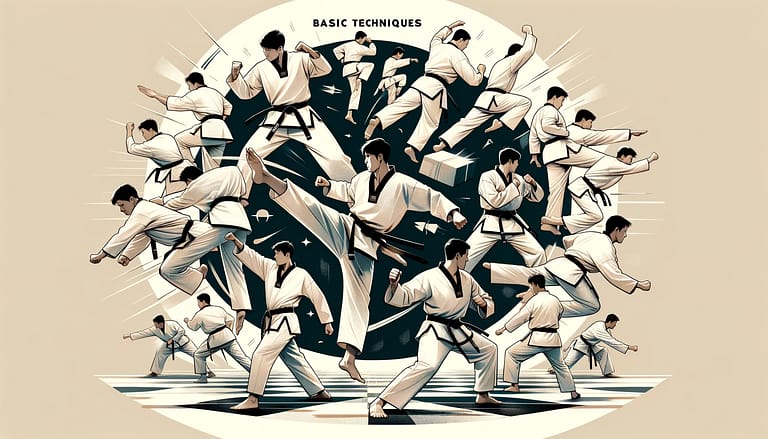
Basic taekwondo blocks and punches are the foundation of Taekwondo and include various strikes, kicks, blocks, and stances. The techniques are designed to develop balance, strength, speed, coordination, and flexibility.
Kicks are a fundamental part of Taekwondo and include front, side, roundhouse, and back kicks. Each kick requires different levels of flexibility and coordination. Some basic strikes, such as taekwondo blocks and punches, include punches and knife-hand strikes, delivered using a clenched fist or the side of the hand, respectively.
Blocks, a crucial part of taekwondo blocks and punches, are used to defend against an opponent’s attacks and can be executed using various body parts, such as the arms and legs. Stances provide practitioners with a solid foundation for their techniques, including front stances, back stances, and horse stances.
Training in basic taekwondo blocks and punches is crucial for mastering more advanced techniques and sparring. Practising and perfecting the basics ensures proper form, accuracy, and technique and allows practitioners to build a strong foundation for their martial arts journey.
Please click on the red checkmarks “✓” for more information!
Stances - Kubi & Seogi
Understanding the Foundation
In Taekwondo, stances are the foundation of all techniques, providing balance, stability, and readiness. Two primary types of stances are central to Taekwondo training: Kubi and Seogi.
Kubi – The Bending Stances
Kubi refers to the bending stances, characterized by the bending of knees. These stances are crucial for maintaining balance and generating power in techniques. The different types of Kubi stances include:
Ap Kubi (Front Stance): A long stance with one leg forward and bent, and the back leg straight. This stance focuses on stability in forward and backward movements.
Dwit Kubi (Back Stance): A stance where the weight is on the back leg, which is bent, and the front leg is slightly bent. It is used for quick lateral movements and defensive techniques.
Juchum Seogi (Horse Riding Stance): A symmetrical stance with both knees bent equally, resembling sitting on a horse. It provides a strong base for executing techniques with power.
Seogi – The Standing Stances
Seogi refers to the standing stances, where the legs are less bent compared to Kubi. They are fundamental in developing balance and readiness. Some common Seogi
stances include:
Charyeot Seogi (Attention Stance): The feet are together, and the body is erect with arms straight and hands forming fists at the side. This stance is used to show respect and readiness.
Moa Seogi (Closed Stance): The feet are together, forming a stable base. This stance is often used as a transitional posture and for certain defensive techniques.
Naranhi Seogi (Parallel Stance): The feet are shoulder-width apart, parallel to each other. This stance is used for resting and as a preparatory position for other stances.
Pyonhi Seogi (Ready Stance): This stance involves a relaxed but alert posture, with feet shoulder-width apart and hands in front at belt level. It signifies readiness to begin a form or technique.
Importance in Taekwondo Training
Mastering these stances is essential for any Taekwondo practitioner. They form the basis for the effective execution of kicks, blocks, and strikes. Proper stances ensure balance, maximize the power of techniques, and prevent injuries. They also teach the practitioner about body alignment and control, which are vital for advanced training. Regular practice and understanding of Kubi and Seogi will significantly enhance a student’s performance and effectiveness in Taekwondo.
Blocks - Makki
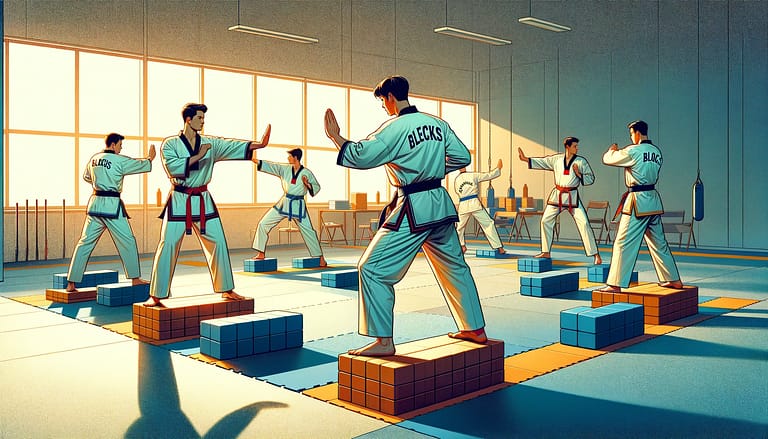
The Art of Defense
In Taekwondo, blocks, known as ‘Makki,’ are fundamental techniques used for defense. They are not just about stopping an attack but also about redirecting the force and preparing for a counter-attack. Mastering various blocks is essential for effective self-defense and sparring.
Types of Makki
Taekwondo features a variety of blocks, each designed for specific types of attacks. Here are some of the commonly practiced blocks:
- Arae Makki (Low Block): This block is used to deflect attacks aimed at the lower
part of the body, typically from the waist down. The block starts from the opposite shoulder and sweeps down across the body.
Momtong Makki (Middle Block): Designed to protect the torso, the middle block is executed by moving the forearm from one side of the body to the other, blocking attacks aimed at the chest and abdomen.
Olgul Makki (High Block): This block is used to defend against attacks targeting the head and upper body. The blocking arm is raised above the head with the forearm positioned to deflect the attack away.
An Makki (Inside Block): Used to defend against attacks coming straight forward, the inside block involves moving the forearm inward, across the body, often preparing for a counter-strike.
Bakkat Makki (Outside Block): This block deflects attacks from the outside. The arm moves outward from the centerline of the body, redirecting the attack away.
Hechyo Makki (Wedge Block): A specialized block where both arms are used simultaneously to form a wedge-like shape, offering protection against a wider range of attacks.
Practicing Blocks
The effectiveness of a block in Taekwondo depends on timing, angle, and the force applied. Practitioners should focus on the following aspects while training:
- Proper Stance: The stance provides stability and balance, making the block more effective.
- Timing and Speed: Blocks should be quick and timely to successfully deflect or stop the attack.
- Accuracy: Correct positioning of the arms and hands is crucial for the block to work effectively.
- Counter-Attacks: Often, blocks are used to create opportunities for counter-attacks. Practitioners should learn to transition smoothly from defense to offense.
Incorporating Makki in Training
Regular practice of blocks is essential in Taekwondo training. Drills, poomsae (forms), and sparring sessions are all opportunities to refine blocking techniques. Beginners start with basic blocks and gradually move to more complex combinations and applications in sparring.
Blocks are not just defensive maneuvers; they are an expression of the art of Taekwondo. A well-executed block demonstrates a practitioner’s skill, control, and understanding of the martial art.
Strikes - Jireugi, Chigi
The Power of Precision and Technique
In Taekwondo, striking techniques are fundamental components of both self-defence and sparring. Among these, Jireugi (punches) and Chigi (strikes other than punches) play a pivotal role. Mastery of these techniques is essential for delivering powerful and effective attacks.
Jireugi – The Art of Punching
Jireugi refers to punching techniques in Taekwondo. These punches are characterized by their precision, speed, and power. Some common forms of Jireugi include:
Baro Jireugi (Straight Punch): A direct punch where the fist travels straight from the guard position to the target, typically the opponent’s torso or face.
Dung Jumeok Jireugi (Backfist Strike): A quick, snapping strike using the back of the fist, often targeting the side of the head or the temple.
Bandae Jireugi (Reverse Punch): Delivered with the rear hand, this powerful punch is executed while stepping forward or in a stationary stance.
Me Jumeok Jireugi (Hammer Fist Strike): This strike uses the side of the clenched fist, like a hammer, to hit downward or sideways against various targets.
Chigi – Various Striking Techniques
Chigi encompasses a wide range of striking techniques that utilize different parts of the hand or arm, excluding the fist. These strikes are versatile and can be used in various combat situations. Key types of Chigi include:
Pyonsonkkeut Chigi (Spear Hand Strike): A thrusting strike with the fingertips, targeting soft or vulnerable areas of the opponent’s body.
Sonkal Chigi (Knife Hand Strike): Using the edge of an open hand, this strike is effective for attacking the neck, collarbone, or ribs.
Palmok Chigi (Forearm Strike): Involves using the forearm as a striking tool, useful for both offensive and defensive manoeuvres
Ollyo Chigi (Upward Strike): An upward motion strike, often targeting the chin or the nose, executed with the palm, fist, or kknife-hand.
Integrating Strikes in Taekwondo
Effective striking in Taekwondo is not just about force; it also requires proper technique, body alignment, and balance. Practitioners should focus on:
- Accuracy and Control: Striking the intended target accurately while maintaining control to avoid overextension or llosingbalance.
- Combination and Fluidity: Combining strikes with other techniques like blocks and kicks for effective offensive and defensive strategies.
- Power Generation: Using the whole body, especially the hips, to generate maximum power in strikes.
Regular practice of Jireugi and Chigi, through forms (poomsae), pad work, and sparring, helps practitioners develop these skills effectively.
Conclusion
Jireugi and Chigi are more than just attack techniques; they embody the essence of Taekwondo – the harmony of mind, body, and spirit. Mastery of these striking techniques enhances a practitioner’s capability in both self-defence and competitive Taekwondo.
Kicks - Chagi
The Elegance of Power and Precision
In Taekwondo, kicks, known as ‘Chagi’, are not just techniques; they are the art form’s essence, embodying its dynamism, precision, and grace. Mastering various kicks is crucial for any practitioner, as they are central to Taekwondo’s identity as a martial art.
Types of Chagi
Taekwondo is renowned for its diverse and powerful kicking techniques. Each type of kick serves a specific purpose and requires a unique combination of balance, strength, and flexibility. Some of the fundamental kicks include:
Ap Chagi (Front Kick): A basic yet versatile kick, delivered straight forward from the practitioner to the target. It’s effective for both defense and offense.
Dollyo Chagi (Roundhouse Kick): A circular kick where the practitioner strikes the target with the instep. It’s known for its speed and is widely used in sparring.
Yop Chagi (Side Kick): Delivered with the foot’s heel, this powerful kick is executed by lifting the knee and extending the leg sideways towards the target.
Dwit Chagi (Back Kick): A potent kick where the practitioner strikes the target by thrusting the heel backwards without looking.
Naeryeo Chagi (Axe Kick): Involving a downward motion, this kick is performed by lifting the leg up straight and bringing it down swiftly, striking with the heel.
Bandae Dollyo Chagi (Reverse Roundhouse Kick): A more advanced kick, striking the target with the back of the heel in a hooking motion, usually targeting the head.
Training and Practice
Effective kicking in Taekwondo involves several key components:
- Flexibility and Strength: Regular stretching and strength training are essential to perform kicks with a full range of motion and power.
- Balance and Posture: Maintaining balance while executing kicks is crucial. Proper posture enhances the effectiveness and minimizes the risk of injury.
- Speed and Precision: Kicks should be executed swiftly and accurately to ensure they are effective in both sparring and self-defense scenarios.
- Breath Control: Proper breathing techniques enhance the power and stability of kicks.
Application in Taekwondo
Kicks in Taekwondo are used in patterns (poomsae), sparring, and self-defense. They are not only physical techniques but also a way to develop discipline, focus, and control. Practicing kicks improves overall body coordination and agility, which are vital for a Taekwondo practitioner.
Conclusion
Chagi in Taekwondo is more than just kicking; it’s a symphony of movement, power, and precision. Whether for competition, fitness, or self-defense, the practice of these kicks is integral to the journey of any Taekwondo student.
Begin Your Taekwondo Journey with “Taekwondo Basics”
Are you ready to dive into the world of Taekwondo? Uncover the fundamentals with “Taekwondo Basics: Everything You Need to Get Started in Taekwondo”, a fantastic guide by Scott Shaw. This paperback edition, released on November 13, 2018, is a perfect starting point for beginners.
Readers’ Reviews:
Average Rating: 4.6/5 stars (based on 64 ratings)
Get Started Today!
Start your Taekwondo journey with “Taekwondo Basics” on Amazon. Check it out now and begin your path to mastering basic kicks, training, and competition in Taekwondo.
Explore more titles in the Tuttle Martial Arts Basics series for comprehensive learning.
Taegeuk Poomsae (coloured belts)

Taegeuk Poomsae in Taekwondo
Taegeuk poomsae is a series of eight forms used in Taekwondo to train students from the beginner to the intermediate level. The forms are used to develop proper technique, balance, and strength while introducing students to the principles and philosophies of martial art.
Symbolism and Structure
Each Taegeuk poomsae consists of a sequence of movements performed in a set pattern, representing a specific attack or defence technique. The forms are named after the Taegeuk symbol, which represents the balance of opposites in the universe and is divided into four parts: Heaven, Earth, Fire, and Water.
Coloured Belt Poomsae
The first four Taegeuk poomsae (Taegeuk Il Jang, Taegeuk Ee Jang, Taegeuk Sam Jang, and Taegeuk Sa Jang) are designed for the coloured belts, from white to red. They introduce the fundamental techniques of Taekwondo and help students develop their skills in stances, blocks, strikes, and kicks.
Taegeuk Il Jang
Taegeuk Il Jang is the first form and consists of eighteen movements. It emphasizes the basic techniques of stepping, front stances, and low blocks.
Taegeuk Ee Jang
Taegeuk Ee Jang is the second form and consists of twenty movements. It emphasizes the basic techniques of back stances, inward blocks, and middle punches.
Taegeuk Sam Jang
Taegeuk Sam Jang is the third form and consists of twenty movements. It emphasizes the basic techniques of knife-hand blocks, knife-hand strikes, and roundhouse kicks.
Taegeuk Sa Jang
Taegeuk Sa Jang is the fourth form and consists of twenty-five movements. It emphasizes the basic techniques of walking stances, middle blocks, and turning kicks.
Taegeuk Oh Jang
Taegeuk Oh Jang is the fifth form and consists of twenty movements. It builds upon the foundation of the previous forms and introduces techniques like double knife-hand blocks and jumping front kicks.
Taegeuk Yuk Jang
Taegeuk Yuk Jang is the sixth form and consists of twenty-three movements. It focuses on techniques such as twin forearm blocks and various kicks, showcasing a higher level of complexity.
Taegeuk Chil Jang
Taegeuk Chil Jang is the seventh form and consists of twenty-four movements. It introduces techniques like high-section turning kicks and circular block strikes, further challenging the practitioner’s skills.
Taegeuk Pal Jang
Taegeuk Pal Jang is the eighth form and consists of twenty-six movements. It emphasizes advanced techniques like double knife-hand strikes and fast-spinning kicks, pushing the practitioner’s capabilities to an even higher level.
Enhance Your Taekwondo Poomsae Skills with Informative Books
The Explanation Of Official Taekwondo Poomsae (Korean-English)
Delve into “The Explanation Of Official Taekwondo Poomsae (Korean-English)”, a valuable resource by Il-pil Kang. This Korean-English paperback edition, released on January 1, 2007, provides in-depth insights into Taekwondo Poomsae.
Reader Rating: 4.6/5 stars (based on 56 ratings)
Get your copy from Amazon and elevate your Poomsae knowledge.
The Explanation of Official Taekwondo Poomsae II: Taekwondo Basics
Continue your learning journey with “The Explanation of Official Taekwondo Poomsae II: Taekwondo Basics” by Ikpil Kang. This Korean edition paperback, released on December 1, 2016, is a must-have for those seeking a comprehensive understanding of Taekwondo Poomsae.
Reader Rating: 4.6/5 stars (based on 77 ratings)
Secure your copy from Amazon and dive into the essentials of Taekwondo Poomsae.
The meaning of Taegeuk Poomsae for coloured belts
Taegeuk Il Jang
Taegeuk Il Jang is one of the eight patterns or forms in the traditional taekwondo poomsae (also spelt poomsae or poomse) curriculum. The taegeuk poomsae are named after the eight trigrams of the I Ching, and each poomsae is associated with a specific trigram and set of principles. Poomsae are predetermined sequences of taekwondo techniques performed alone as a form of training and development.
Taegeuk Il Jang is the first of the taegeuk poomsae and is associated with the trigram. (Gi), which represents the principle of yang (?) or “heaven.” The poomsae consists of kicks, punches, blocks, and stances, typically performed by lower belt students. The movements of Taegeuk Il Jang are intended to represent the creation of the universe and the balance of yin and yang.
Taegeuk I Jang
Taegeuk Ee Jang or Taegeuk I Jang s the second of the eight patterns or forms in the traditional taekwondo poomsae (also spelt poomsae or poomse) curriculum. The taegeuk poomsae are named after the eight trigrams of the I Ching, and each poomsae is associated with a specific trigram and set of principles. Poomsae are predetermined sequences of taekwondo techniques performed alone as a form of training and development.
Taegeuk Ee Jang is the second of the taegeuk poomsae and is associated with the trigram. (Goo), which represents the principle of yin (?) or “earth.” The poomsae consists of kicks, punches, blocks, and stances, typically performed by lower belt students. The movements of Taegeuk Ee Jang are intended to represent the creation of the universe and the balance of yin and yang.
Taegeuk Sam Jang
Taegeuk Sam Jang is the third of the eight patterns or forms in the traditional taekwondo poomsae (also spelt poomsae or poomse) curriculum. Poomsae are predetermined sequences of taekwondo techniques performed alone as a form of training and development. The taegeuk poomsae are named after the eight trigrams of the I Ching, and each poomsae is associated with a specific trigram and set of principles.
Taegeuk Sam Jang is the third of the taegeuk poomsae and is associated with the trigram. (Ee), which represents the principle of fire. The poomsae consists of a series of kicks, punches, blocks, and stances, typically performed by lower belt students. The movements of Taegeuk Sam Jang are intended to represent the creation of the universe and the balance of yin and yang.
Taegeuk Sa Jang
Taegeuk Sa Jang is the fourth of the eight patterns or forms in the traditional taekwondo poomsae (also spelt pumsae or poomse) curriculum. The taegeuk poomsae are named after the eight trigrams of the I Ching, and each poomsae is associated with a specific trigram and set of principles. Poomsae are predetermined sequences of taekwondo techniques performed alone as a form of training and development.
Taegeuk Sa Jang is the fourth taegeuk poomsae associated with the trigram (Jeong), representing the principle of thunder. The poomsae consists of kicks, punches, blocks, and stances, typically performed by lower belt students. The movements of Taegeuk Sa Jang are intended to represent the creation of the universe and the balance of yin and yang.
Taegeuk Oh Jang
Taegeuk O Jang is the fifth of the eight patterns or forms in the traditional taekwondo poomsae (also spelt pumsae or poomse) curriculum. The taegeuk poomsae are named after the eight trigrams of the I Ching, and each poomsae is associated with a specific trigram and set of principles. Poomsae are predetermined sequences of taekwondo techniques performed alone as a form of training and development.
Taegeuk O Jang is the fifth of the taegeuk poomsae and is associated with the trigram. (Won), which represents the principle of wind. The poomsae consists of a series of kicks, punches, blocks, and stances, typically performed by lower belt students. The movements of Taegeuk O Jang are intended to represent the creation of the universe and the balance of yin and yang.
Taegeuk Yuk Jang
Taegeuk Yuk Jang is the sixth of the eight patterns or forms in the traditional taekwondo poomsae (also spelt pumsae or poomse) curriculum. The taegeuk poomsae are named after the eight trigrams of the I Ching, and each poomsae is associated with a specific trigram and set of principles. Poomsae are predetermined sequences of taekwondo techniques performed alone as a form of training and development.
Taegeuk Yuk Jang is the sixth of the taegeuk poomsae and is associated with the trigram. (Jin), which represents the principle of water. The poomsae consists of kicks, punches, blocks, and stances, typically performed by lower belt students. The movements of Taegeuk Yuk Jang are intended to represent the creation of the universe and the balance of yin and yang.
Taegeuk Chil Jang
Taegeuk Chil Jang is the seventh of the eight patterns or forms in the traditional taekwondo poomsae (also spelt pumsae or poomse) curriculum. Poomsae are predetermined sequences of taekwondo techniques performed alone as a form of training and development. The taegeuk poomsae are named after the eight trigrams of the I Ching, and each poomsae is associated with a specific trigram and set of principles.
Taegeuk Chil Jang is the seventh of the taegeuk poomsae and is associated with the trigram. (Gye), which represents the principle of the mountain. The poomsae consists of kicks, punches, blocks, and stances, typically performed by lower belt students. The movements of Taegeuk Chil Jang are intended to describe the creation of the universe and the balance of yin and yang.
Taegeuk Pal Jang
Taegeuk Pal Jang is the eighth and final of the patterns or forms in the traditional taekwondo poomsae (also spelt pumsae or poomse) curriculum. The taegeuk poomsae are named after the eight trigrams of the I Ching, and each poomsae is associated with a specific trigram and set of principles. Poomsae are predetermined sequences of taekwondo techniques performed alone as a form of training and development.
Taegeuk Pal Jang is the eighth and final of the taegeuk poomsae and is associated with the trigram. (Chil), which represents the principle of earth. The poomsae consists of kicks, punches, blocks, and stances, typically performed by lower belt students. The movements of Taegeuk Pal Jang are intended to describe the creation of the universe and the balance of yin and yang.
The meaning of Black Belt Poomsae
Koryo
Koryo is the name of one of the poomsae (also spelt pumsae or poomse) in the traditional taekwondo curriculum. Poomsae are predetermined sequences of taekwondo techniques performed alone as a form of training and development. Koryo is the first black belt poomsae named after the Korean Goryeo Dynasty, which ruled from the 10th to the 14th centuries. The movements in the Koryo poomsae are based on the fluid and dynamic techniques of the Goryeo period martial artists. The poomsae consists of a series of kicks, punches, blocks, and stances and is typically performed by students who have achieved a black belt rank.
World Taekwondo, formerly known as the World Taekwondo Federation (WTF), is the international federation for Taekwondo and is responsible for organizing and promoting the sport of Taekwondo around the world. World Taekwondo sets the rules and regulations for competitions and sponsors international tournaments, including the World Taekwondo Championships and the Olympic Games. The Koryo poomsae is recognized and practised by World Taekwondo and several other poomsae that are part of the traditional taekwondo curriculum.
Keumgang
Keumgang is the name of one of the poomsae (also spelt pumsae or poomse) in the traditional taekwondo curriculum. Poomsae are predetermined sequences of taekwondo techniques performed alone as a form of training and development. Keumgang is the second black belt poomsae named after Korea’s diamond mountain (Keumgang). The movements in the Keumgang poomsae are based on the hardness and clarity of the diamond and are intended to represent the indomitable spirit of the martial artist. The poomsae consists of a series of kicks, punches, blocks, and stances and is typically performed by students who have achieved a black belt rank.
World Taekwondo, formerly known as the World Taekwondo Federation (WTF), is the international federation for Taekwondo and is responsible for organizing and promoting the sport of Taekwondo around the world. World Taekwondo sets the rules and regulations for competitions and sponsors international tournaments, including the World Taekwondo Championships and the Olympic Games. The Keumgang poomsae is recognized and practised by World Taekwondo and several other poomsae that are part of the traditional taekwondo curriculum.
Taebaek
Taebaek is the name of one of the poomsae (also spelt pumsae or poomse) in the traditional taekwondo curriculum. Poomsae are predetermined sequences of taekwondo techniques performed alone as a form of training and development. Taebaek is the third black belt poomsae named after the Taebaek mountain range in Korea. The movements in the Taebaek poomsae are based on the strength and stability of the mountains and are intended to represent the power and solidity of the martial artist. The poomsae consists of a series of kicks, punches, blocks, and stances and is typically performed by students who have achieved a black belt rank.
Pyongwon
Pyongwon is the name of one of the poomsae (also spelt pumsae or poomse) in the traditional taekwondo curriculum. Poomsae are predetermined sequences of taekwondo techniques performed alone as a form of training and development. Pyongwon is the fourth black belt poomsae and is named after Korea’s “plain of peace” (Pyongwon). The movements in the Pyongwon poomsae are based on the vastness and openness of the plain and are intended to represent the martial artist’s readiness for any challenge. The poomsae consists of a series of kicks, punches, blocks, and stances and is typically performed by students who have achieved a black belt rank.
World Taekwondo, formerly known as the World Taekwondo Federation (WTF), is the international federation for Taekwondo and is responsible for organizing and promoting the sport of Taekwondo around the world. World Taekwondo sets the rules and regulations for competitions and sponsors international tournaments, including the World Taekwondo Championships and the Olympic Games. The Pyongwon poomsae is recognized and practised by World Taekwondo and several other poomsae that are part of traditional Taekwondo.
Sipjin
Sipjin is the name of one of the poomsae (also spelt pumsae or poomse) in the traditional taekwondo curriculum. Poomsae are predetermined sequences of taekwondo techniques performed alone as a form of training and development. Sipjin is the fifth of the black belt poomsae and is named after the “ten stars” (Sipjin) in the Korean constellation. The movements in the Sipjin poomsae are based on the ten celestial stems and twelve earthly branches of the East Asian zodiac. They represent the martial artist’s enduring spirit and timeless wisdom. The poomsae consists of a series of kicks, punches, blocks, and stances and is typically performed by students who have achieved a black belt rank.
World Taekwondo, formerly known as the World Taekwondo Federation (WTF), is the international federation for Taekwondo and is responsible for organizing and promoting the sport of Taekwondo around the world. World Taekwondo sets the rules and regulations for competitions and sponsors international tournaments, including the World Taekwondo Championships and the Olympic Games. The Sipjin poomsae is recognized and practised by World Taekwondo, along.
Jitae
Jitae is the name of one of the poomsae (also spelt pumsae or poomse) in the traditional taekwondo curriculum. Poomsae are predetermined sequences of taekwondo techniques performed alone as a form of training and development. The poomsae consists of a series of kicks, punches, blocks, and stances and is typically performed by students who have achieved a black belt rank. Jitae is the sixth of the black belt poomsae and is named after the “seven stars” (Jitae) in the Korean constellation. The movements in the Jitae poomsae are based on the seven celestial stems and eight earthly branches of the East Asian zodiac. They are intended to represent the martial artist’s nobility and honour.
World Taekwondo, formerly known as the World Taekwondo Federation (WTF), is the international federation for Taekwondo and is responsible for organizing and promoting the sport of Taekwondo around the world. World Taekwondo sets the rules and regulations for competitions and sponsors international tournaments, including the World Taekwondo Championships and the Olympic Games. The Jitae poomsae is recognized and practised by World Taekwondo and several other poomsae that are part of the traditional taekwondo curriculum.
Chonkwon
Chonkwon is the name of one of the poomsae (also spelt pumsae or poomse) in the traditional taekwondo curriculum. Poomsae are predetermined sequences of taekwondo techniques performed alone as a form of training and development. The poomsae consists of a series of kicks, punches, blocks, and stances and is typically performed by students who have achieved a black belt rank. Chonkwon is the seventh black belt poomsae named after Korea’s “heavenly lake” (Chonkwon). The movements in the Chonkwon poomsae are based on the fluid and graceful movements of water and are intended to represent the martial artist’s fluidity and adaptability.
World Taekwondo, formerly known as the World Taekwondo Federation (WTF), is the international federation for Taekwondo and is responsible for organizing and promoting the sport of Taekwondo around the world. World Taekwondo sets the rules and regulations for competitions and sponsors international tournaments, including the World Taekwondo Championships and the Olympic Games. The Chonkwon poomsae is recognized and practised by World Taekwondo, along with several other poomsae that are part of the traditional taekwondo curriculum.
Hansu
Hansu is the eighth black belt poomsae named after the “water” (Hansu) in the Korean language. Hansu is the name of one of the poomsae (also spelt pumsae or poomse) in the traditional taekwondo curriculum. Poomsae are predetermined sequences of taekwondo techniques performed alone as a form of training and development. The poomsae consists of a series of kicks, punches, blocks, and stances and is typically performed by students who have achieved a black belt rank. The movements in the Hansu poomsae are based on water’s fluid and flexible nature and represent the martial artist’s adaptability and versatility.
World Taekwondo, formerly known as the World Taekwondo Federation (WTF), is the international federation for Taekwondo and is responsible for organizing and promoting the sport of Taekwondo around the world. World Taekwondo sets the rules and regulations for competitions and sponsors international tournaments, including the World Taekwondo Championships and the Olympic Games. The Hansu poomsae is recognized and practised by World Taekwondo and several other poomsae that are part of the traditional taekwondo curriculum.
Ilyeo
Ilyeo is the name of one of the poomsae (also spelt pumsae or poomse) in the traditional taekwondo curriculum. Poomsae are predetermined sequences of taekwondo techniques performed alone as a form of training and development. Ilyeo is the ninth black belt poomsae and is named after the “one” (Ilyeo) in the Korean language. The movements in the Ilyeo poomsae are based on the unity and wholeness of the martial artist and are intended to represent the martial artist’s indivisibility and completeness. The poomsae consists of a series of kicks, punches, blocks, and stances and is typically performed by students who have achieved a black belt rank.
World Taekwondo, formerly known as the World Taekwondo Federation (WTF), is the international federation for Taekwondo and is responsible for organizing and promoting the sport of Taekwondo around the world. World Taekwondo sets the rules and regulations for competitions and sponsors international tournaments, including the World Taekwondo Championships and the Olympic Games. The Ilyeo poomsae is recognized and practised by World Taekwondo and several other poomsae that are part of the traditional taekwondo curriculum.
Blackbelt Poomsae
Introduction to Black Belt Poomsae
In Taekwondo, once a practitioner has reached the rank of black belt, they can begin learning the black belt poomsae. These poomsae are a set of advanced forms that require a high level of skill and discipline to perform correctly.Eight Black Belt Poomsae
There are eight black belt poomsae, each building on the skills and techniques learned in the previous forms. The first black belt poomsae is called Koryo, emphasising power, stability, and control.Keumgang: The Second Poomsae
The second black belt poomsae is called Keumgang, which emphasises using the mind to control the body. This form features solid and dynamic movements and requires the practitioner to demonstrate great focus and concentration.Taebaek: The Third Poomsae
The third black belt poomsae is called Taebaek, and it focuses on the use of fluid, graceful movements to create a sense of harmony and balance.Pyongwon: The Fourth Poomsae
The fourth black belt poomsae, called Pyongwon, emphasises circular movements to create a sense of flow and rhythm. This form also requires the practitioner to demonstrate precision and accuracy in their techniques.Sipjin: The Fifth Poomsae
The fifth black belt poomsae is called Sipjin, which emphasises the use of explosive power and speed in the execution of techniques. This form also features complex footwork and requires the practitioner to maintain a high level of energy and focus throughout.Jitae: The Sixth Poomsae
The sixth black belt poomsae, called Jitae, emphasises balance and stability to create a sense of strength and power. This form also features a variety of kicks and requires the practitioner to demonstrate great flexibility and control.Cheonkwon: The Seventh Poomsae
The seventh black belt poomsae, called Cheonkwon, focuses on circular movements to create a sense of flow and harmony. This form requires the practitioner to demonstrate great power and control in their techniques.Hansoo: The Eighth Poomsae
The final black belt poomsae is called Hansoo, emphasising fluid, graceful movements to create a sense of balance and harmony. This form requires the practitioner to demonstrate great control and precision in their techniques.Ilyeo: The Ninth Poomsae
Ilyeo is the ninth black belt poomsae, emphasizing further refinement of skills and techniques acquired in the previous forms. This form represents the practitioner’s continued journey towards mastery.Conclusion
Overall, the black belt poomsae are an essential part of the Taekwondo curriculum and represent the highest level of skill and discipline in martial arts.Taegeuk Poomsae @Taekwondo4Fitness

Taegeuk Poomsae is a series of movements or forms in Taekwondo that are performed in a specific sequence. There are eight Taegeuk Poomsae forms, each representing a different level of skill and expertise in Taekwondo.
During a Taegeuk Poomsae performance, a practitioner will perform a series of techniques, including kicks, punches, blocks, and stances, in a fluid and controlled manner. The movements are designed to develop strength, balance, flexibility, and focus while showcasing the practitioner’s skill and mastery of the techniques.
The performance of a Taegeuk Poomsae is judged based on several factors, including the accuracy and execution of the techniques, the overall fluidity and grace of the performance, and the practitioner’s control and composure throughout the form.
In summary, Taegeuk Poomsae is a fundamental component of Taekwondo training, requiring physical and mental discipline to perform at a high level.
Benefits of Taekwondo

Taekwondo: Physical and Mental Benefits
Taekwondo is a Korean martial art that has gained popularity worldwide. It is a dynamic and challenging sport that requires strength, flexibility, agility, and mental focus.
Benefits of Practising Taekwondo
- Physical fitness: Taekwondo is an excellent workout that promotes physical fitness. It improves cardiovascular health, increases muscular strength, and develops flexibility and agility.
- Self-defence: Taekwondo teaches effective self-defence techniques that can be used in real-life situations. It helps develop awareness, confidence, and quick reflexes.
- Mental discipline: Taekwondo training emphasizes mental discipline and focus. Practitioners learn to control their emotions and develop concentration, perseverance, and self-control.
- Character development: Taekwondo training fosters the development of positive character traits such as respect, humility, and perseverance. It instils a sense of responsibility, and practitioners learn to apply these values daily.
- Stress relief: Taekwondo can be a great stress reliever. Intense physical activity releases endorphins, which promote well-being and reduce stress levels.
- Social interaction: Taekwondo classes provide opportunities for social interaction and community building. Practitioners can make new friends, learn from their peers, and develop a sense of belonging.
Summary
Taekwondo is a sport that offers many physical and mental benefits. The benefit of Taekwondo include promoting physical fitness, self-defence, mental discipline, character development, stress relief, and social interaction. Practising Taekwondo helps individuals improve their overall health, enhance their ability to protect themselves, cultivate self-discipline and respect, develop a strong and positive character, reduce stress levels through physical activity, and enjoy the camaraderie of training with others. This makes the benefit of Taekwondo comprehensive, impacting various aspects of personal development and well-being.
History of Taekwondo
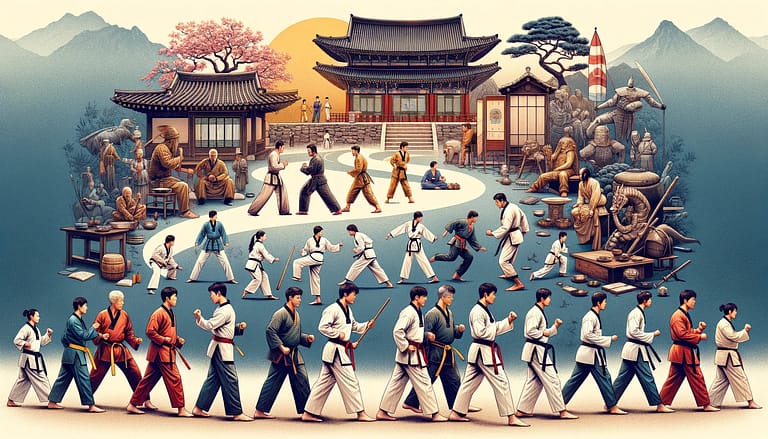
Taekwondo is a martial art that originated in Korea over 2,000 years ago. It is rooted in the traditional Korean martial arts of Taekkyeon and Subak, practised during the Three Kingdoms period of Korea (57 BC – 668 AD).
During the Joseon Dynasty (1392-1910), martial arts were popularized throughout Korea as self-defence against foreign invaders. However, it was not until the 20th century that modern Taekwondo emerged.
In 1945, Korea was liberated from Japanese occupation, and Korean martial arts underwent a period of modernization and standardization. In 1955, General Choi Hong Hi, along with other Korean martial arts masters, formed the Korea Taekwondo Association (KTA) to promote and develop Taekwondo as a national sport.
In 1961, the KTA created a new form of Taekwondo called “Chang Hon Taekwondo,” which emphasized a standardized curriculum and the use of forms, or poomsae, as training. In 1972, the KTA merged with several other martial arts organizations to form the World Taekwondo Federation (WTF), which became the international governing body for Taekwondo.
Since then, Taekwondo has become one of the most popular martial arts in the world, with millions of practitioners in over 200 countries. It has also become an Olympic sport, with Taekwondo making its debut as a demonstration sport in the 1988 Seoul Olympics and becoming an official Olympic sport in the 2000 Sydney Olympics.
Today, Taekwondo is practised by people of all ages and skill levels, and it continues to evolve and develop as a martial art and sport.
A Killing Art: The Untold History of Tae Kwon Doe
Audible Audiobook – Unabridged
Author: Alex Gillis
Narrator: Ramon De Ocampo
Publisher: Audible Studios
Basics - Self-Defence
Blocks
Taekwondo includes various blocks that can deflect and nullify an attack. Blocks can be executed with various body parts, including the arms, legs, and hands.
Strikes
Taekwondo techniques also include various strikes that can be used to counterattack an opponent. These include punches, kicks, and elbow strikes, which can be executed with speed and power.
Joint Locks and Holds
Joint locks and holds are grappling techniques used to immobilize an opponent. These techniques can be used to subdue an attacker without causing serious harm.
Throws and Takedowns
Throws and takedowns are techniques used to bring an opponent to the ground. They can create distance and provide an opportunity to escape from an attacker.
Awareness and Avoidance
In addition to physical techniques, Taekwondo training emphasizes situational awareness and avoidance. Practitioners learn to recognize potentially dangerous situations and take steps to avoid them.
By learning these self-defence techniques, Taekwondo practitioners develop confidence in their ability to protect themselves. However, it is essential to note that self-defence should always be a last resort, and Taekwondo training emphasizes the importance of avoiding confrontation whenever possible.
Basics - One Step Sparring
One Step Sparring, also known as Ilbo Matsogi in Korean, is a training exercise in Taekwondo that focuses on developing timing, distancing, and technique. It is a fundamental part of Taekwondo basics and is often used in belt tests and competitions.
In One Step Sparring, one person plays the role of the attacker, and the other person plays the role of the defender. The attacker performs a pre-determined attack, such as a punch or a kick, and the defender responds with a specific defence technique, such as a block or a counterattack.
One Step Sparring is designed to simulate a real-life situation where an opponent attacks a person. The pre-determined nature of the exercise allows practitioners to focus on developing their technique and reaction time without the unpredictability of a real-life situation.
One Step Sparring is typically performed in a sequence, with the attacker and defender switching roles after each technique. It is often performed with a partner of similar skill level and can be adapted to suit different levels of experience and ability.
One Step Sparring is integral to Taekwondo basics because it allows practitioners to develop essential skills such as accuracy, control, and speed. It also provides a structured environment for practising self-defence techniques in a safe and controlled manner. As practitioners advance in their training, One Step Sparring can become more complex, with multiple attacks and defences performed in rapid succession.
Basics - Sparring
Sparring, also known as Kyorugi in Korean, is a form of training in Taekwondo that involves two practitioners engaging in a controlled, competitive fight. It is an essential aspect of Taekwondo basics and is a requirement for advancing through the ranks.
In sparring, practitioners wear protective gear such as helmets, gloves, chest protectors, and shin guards to minimize the risk of injury. Sparring aims to score points by landing controlled strikes on the opponent’s scoring zones, which include the torso, head, and legs.
Sparring allows practitioners to apply their techniques in a dynamic and realistic setting. It requires practitioners to use their footwork, timing, and strategy to outmanoeuvre and strike their opponent while avoiding being struck themselves.
Sparring can be performed in different formats, including light contact, semi-contact, and full contact. The intensity of the sparring can vary depending on the skill level and experience of the practitioners.
Sparring is an essential part of Taekwondo training because it helps practitioners develop physical and mental discipline and improve their overall fitness and reflexes. It also allows practitioners to test themselves against other practitioners and gain confidence in their abilities.
Through sparring, Taekwondo practitioners learn essential values such as respect, self-control, and sportsmanship. They also understand the importance of practising martial arts in a safe and controlled environment.
Taekwondo Basics for Kids
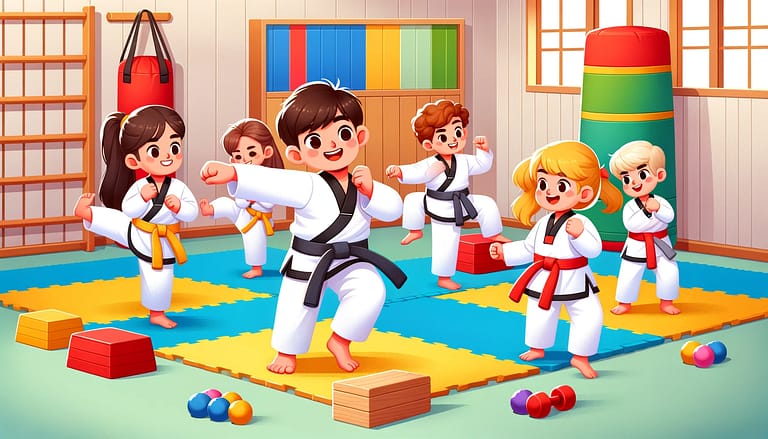
Etiquette
Taekwondo training emphasizes the importance of respect, discipline, and courtesy. Children are taught to bow to their instructors and fellow students, listen attentively and follow instructions.
Basic Techniques
Taekwondo basics for kids include learning basic techniques such as punches, kicks, blocks, and stances. These techniques are taught progressively, emphasizing proper form and technique.
Patterns
Patterns, also known as poomsae or forms, are a series of movements performed in a specific sequence. They help children develop coordination, balance, and concentration.
Sparring
Sparring is a controlled form of fighting that allows children to apply their techniques in a dynamic and realistic setting. Sparring is usually performed with protective gear and with rules that ensure safety.
Self-Defence
Taekwondo training includes learning techniques for self-defence, such as blocks, strikes, and joint locks. Children are taught to defend themselves against physical attacks in a safe and controlled environment.
Fitness
Taekwondo training can help children improve their overall fitness, including strength, flexibility, and cardiovascular endurance.
Mental Discipline
Taekwondo training emphasizes the importance of mental discipline, including focus, determination, and perseverance. These skills can help children improve their academic performance and develop positive habits.
Taekwondo training for children is typically structured to be fun and engaging, emphasizing teamwork, camaraderie, and personal growth. Children are encouraged to set goals and work towards achieving them, which can help them develop a sense of accomplishment and self-confidence.
Taegeuk Poomsae
Taegeuk poomsae are a set of eight forms that are an integral part of the Taekwondo curriculum. They are designed to teach practitioners the fundamental techniques and principles of Taekwondo in a structured and progressive manner. Each form builds upon the previous one, introducing new techniques and concepts.
The Taegeuk poomsae are named after the eight trigrams of the I Ching, which represent the fundamental principles of the universe in traditional East Asian philosophy. Each form has its unique movements, patterns, and symbolism.
The Taegeuk poomsae are typically performed by practitioners during belt tests and competitions. They are judged based on accuracy, balance, power, and gracefulness. The forms are designed to teach practitioners how to apply their techniques in a practical setting, including self-defence scenarios.
The first four Taegeuk poomsae are designed for beginners and focus on basic techniques such as punches, kicks, and blocks. The last four forms are more complex, with advanced techniques such as jumping kicks and spinning kicks.
In addition to teaching fundamental techniques and principles, the Taegeuk poomsae are also designed to promote mental and spiritual growth. Practitioners must focus on breathing, visualization, and concentration while performing the forms.
Overall, the Taegeuk poomsae are an essential part of the Taekwondo curriculum, providing a structured and progressive way for practitioners to develop their skills and understanding of martial art. They are also an essential part of the cultural heritage of Taekwondo, representing the rich symbolism and philosophy that underpins the art.
Palgwe Poomsae
Palgwe poomsae are a set of eight forms that are an essential part of the Taekwondo curriculum. They were introduced in the mid-20th century as an alternative to the traditional Taegeuk poomsae and were created to represent the eight trigrams of the I Ching. Each form is named after one of the trigrams, which symbolize the fundamental principles of the universe in traditional East Asian philosophy.
Palgwe poomsae are typically performed by practitioners during belt tests and competitions and are judged based on criteria such as accuracy, balance, power, and gracefulness. Each form has its unique movements, patterns, and symbolism.
The Palgwe poomsae are designed to teach practitioners how to apply their techniques in a practical setting, including self-defence scenarios. They focus on fundamental techniques such as punches, kicks, and blocks, as well as more complex movements such as jumps, spins, and sweeps.
In addition to teaching practical self-defence techniques, the Palgwe poomsae are also designed to promote mental and spiritual growth. Practitioners must focus on breathing, visualization, and concentration while performing the forms.
Overall, the Palgwe poomsae are an essential part of the Taekwondo curriculum, providing a structured and progressive way for practitioners to develop their skills and understanding of martial art. They are also an essential part of the cultural heritage of Taekwondo, representing the rich symbolism and philosophy that underpins the art.
WT Black Belt Poomsae
The Essence of Mastery and Tradition
In the World Taekwondo (WT) federation, Black Belt Poomsae represent the pinnacle of form and technique, embodying the depth of Taekwondo’s artistry and philosophy. These forms are not just a demonstration of skill, but also an expression of a practitioner’s journey in martial arts.
Overview of WT Black Belt Poomsae
Black Belt Poomsae in WT are advanced patterns that incorporate complex movements, requiring precision, control, and a deep understanding of Taekwondo principles. Each form is unique and has its own set of challenges and teachings.
Key Black Belt Poomsae
Koryo: The first black belt form, symbolizes the spirit of the Koryo Dynasty, showcasing strength and dignity. It combines dynamic movements with powerful strikes and blocks.
Keumgang: Named after the Diamond Mountains, this Poomsae signifies hardness and strength. It emphasizes strong stances and deliberate movements.
Taebaek: Symbolizing the sacred Taebaek mountains, this form focuses on balance and control, with techniques that demonstrate the harmony of mind and body.
Pyongwon: Meaning ‘plain’, it represents the vastness and simplicity of a plain, combining expansive movements with straightforward techniques.
Sipjin: Represents the longevity of life, incorporating slow and graceful movements that require poise and stable stances.
Jitae: Symbolizing the earth, it focuses on grounding techniques and powerful lower body movements.
Cheonkwon: Named ‘Heaven’s Great Mighty’, it embodies the vastness of the sky with flowing movements and agile techniques.
Hansu: Representing water, this form is characterized by fluidity and adaptability in techniques and transitions.
Ilyeo: Signifying the unity of mind and body, this Poomsae focuses on circular movements and harmonious flow between attack and defense.
Importance in Training
Training in Black Belt Poomsae involves more than just learning the movements. It is about understanding the underlying principles and the philosophy of each form. These Poomsae are:
- Physical and Mental Challenge: They test a practitioner’s ability to combine technique, strength, balance, and flexibility.
- Cultural and Philosophical Insight: Each form is rooted in Korean history and philosophy, offering deeper insights into Taekwondo’s origins.
- Pathway to Mastery: Mastery of these forms represents a high level of understanding and skill in Taekwondo.
Conclusion
The WT Black Belt Poomsae are a critical aspect of Taekwondo training for advanced practitioners. They offer a unique blend of physical challenge, mental discipline, and cultural understanding, making them essential for anyone seeking to master this martial art.
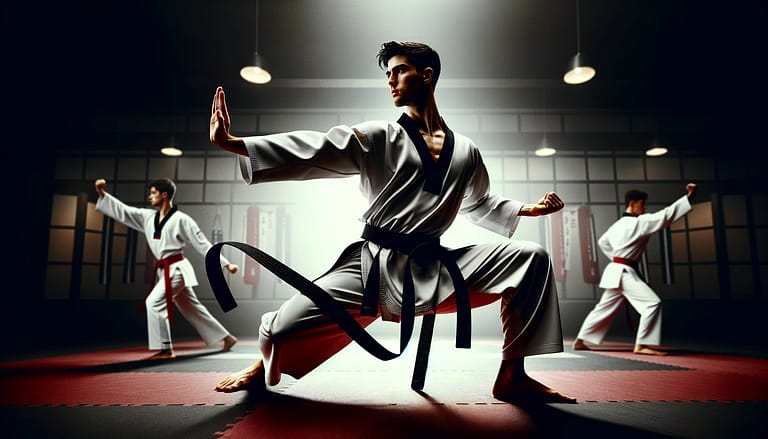
WT Poomsae - Grand Master Kyu Hyung Lee
Grand Master Kyu Hyung Lee is a renowned martial artist and a prominent figure in the world of Taekwondo. He was born in South Korea in 1941 and began martial arts training at a young age, studying under Grand Master Woo-Jin Jung.
Grand Master Lee has achieved numerous accolades throughout his martial arts career. He is a 9th-degree black belt in Taekwondo and has also trained in other martial arts, such as Judo, Hapkido, and Kendo. He has won several competitions in both forms and sparring, including the Korean National Championships and the World Taekwondo Championships.
In addition to his competition success, Grand Master Lee is also known for his contributions to the development and promotion of Taekwondo. He has served as the president of the Korean Taekwondo Association and was a member of the World Taekwondo Federation’s Technical Committee. He has also authored several books on Taekwondo and taught martial art to thousands of students worldwide.
Grand Master Lee has been recognized for his contributions to Taekwondo with several honours and awards. He was inducted into the Taekwondo Hall of Fame and was awarded the Order of Sport Merit by the South Korean government.
Overall, Grand Master Kyu Hyung Lee is a respected figure in the world of Taekwondo, known for his exceptional martial arts skills, teaching abilities, and contributions to the development of the art.
New Kukkiwon Poomsae

The Kukkiwon, also known as the World Taekwondo Headquarters, is the official governing body for Taekwondo and is responsible for developing and promoting martial arts. In 2018, the Kukkiwon introduced five new Kukkiwon TKD poomsae, a set of forms to train and develop Taekwondo skills.
The five new Kukkiwon TKD poomsae are named Koryo, Keumgang, Taebaek, Pyongwon, and Sipjin. These poomsae were designed to supplement the existing forms and to provide practitioners with additional opportunities to develop their skills and abilities.
Each new Kukkiwon TKD poomsae has unique movement patterns and techniques based on different themes and principles. For example, Koryo focuses on solid and forceful movements, named after a Korean dynasty. At the same time, Keumgang emphasizes precision and fluidity and is named after a famous mountain in Korea.
The new Kukkiwon TKD poomsae have been well-received by the Taekwondo community and have been integrated into the curriculum of many schools and training centres around the world. They provide practitioners with a structured and progressive way to develop their skills and abilities and are an essential part of the ongoing evolution of martial arts.
In addition to the physical benefits of practising the new poomsae, they also provide practitioners with opportunities to connect with Korean culture and history. Each form is named after a significant location or period in Korean history, and practitioners are encouraged to learn about the cultural and historical context of each poomsae as they train.
Overall, the new Kukkiwon TKD poomsae represents an exciting development in Taekwondo, providing practitioners with new challenges and opportunities to develop their skills and abilities.
New Poomsae
The Continual Evolution of Taekwondo
Taekwondo, a martial art known for its dynamic techniques and deep-rooted traditions, continually evolves. The introduction of new Poomsae (forms) reflects this ongoing development, bringing fresh perspectives and challenges to practitioners of all levels.
Understanding New Poomsae
New Poomsae in Taekwondo is designed to modernize the training curriculum, incorporating contemporary techniques while respecting traditional foundations. These forms are typically developed by Taekwondo governing bodies, like the World Taekwondo Federation (WTF) or Kukkiwon, to enhance the practice and competition of Taekwondo.
Characteristics of New Poomsae
Innovative Techniques: New Poomsae often introduce novel movements or combinations, pushing the boundaries of traditional Taekwondo techniques.
Balanced Complexity: They strike a balance between technical complexity and physical demands, making them accessible yet challenging for practitioners.
Reflecting Modern Training: These forms are designed considering current training methodologies and athletic science, ensuring they are relevant and beneficial for modern practitioners.
Competition Oriented: Many new Poomsae are crafted with competitive Taekwondo in mind, tailored to showcase athleticism, precision, and artistic expression in tournaments.
Importance of New Poomsae in Training
- Skill Development: Practicing these forms helps students develop agility, strength, coordination, and balance.
- Versatility: They provide a broader range of techniques and strategies, enhancing a practitioner’s adaptability in both sparring and self-defence.
- Engagement: New Poomsae keeps training fresh and engaging, offering new challenges and learning opportunities.
Embracing Change
While traditional Poomsae remains a cornerstone of Taekwondo, the integration of new Poomsae is essential for the art’s growth and relevance in the modern world. They offer practitioners the opportunity to explore different facets of Taekwondo, enriching their overall experience and understanding of the martial arts.
Conclusion
The new Poomsae in Taekwondo are more than just sequences of movements; they are a testament to the art’s evolving nature and its adaptability to the changing times. Practising these forms allows Taekwondo students to be part of the art’s ongoing journey, contributing to its rich and dynamic legacy.
WTF Documentary
The WTF (World Taekwondo Federation) was the official international governing body for the sport of Taekwondo until 2017 when it changed its name to World Taekwondo. The organisation produced a documentary that provides an in-depth look into the history and evolution of the sport of Taekwondo and the role of the WTF in its development.
The documentary, titled “Taekwondo: Beyond the Fight”, features interviews with prominent Taekwondo athletes, coaches, and officials, as well as historical footage and behind-the-scenes glimpses of major Taekwondo events. The film explores the origins of Taekwondo as a martial art and its transformation into a widely recognised competitive sport, with a particular focus on the role of the WTF in promoting and governing the sport.
One of the key themes of the documentary is the evolution of the WTF itself. The organisation was founded in 1973 to unify and promote Taekwondo worldwide. Over the years, the WTF grew in size and influence, overseeing major international competitions such as the Olympic Games and developing a standardised ranking system and competition rules.
In 2017, the WTF changed its name to World Taekwondo to distance itself from negative connotations associated with the acronym “WTF”. The new name also reflects the organisation’s focus on promoting Taekwondo as a sport for all, emphasising inclusivity and diversity.
Overall, the “Taekwondo: Beyond the Fight” documentary provides a fascinating look into the history and evolution of Taekwondo and the role of the WTF (now World Taekwondo) in its development. The film celebrates the sport’s rich cultural heritage and global reach while highlighting the ongoing efforts to make Taekwondo more accessible and inclusive for everyone.
How to Perform a Kukkiwon Dan Check Using TCon

- Access the TCon System: To begin, visit the official TCon website. TCon, or Taekwondo Certification Online Network, is the designated platform for all matters related to Kukkiwon certification, including Kukkiwon certification online services.
- Create an Account: If you are a first-time user, you will need to create an account. Follow the registration process by providing the necessary information. For those who already have an account, simply log in.
- Navigate to Dan Certificate Verification: Once logged in, look for the option to verify Dan certificates. This section is dedicated to checking the authenticity and details of Kukkiwon-issued Dan certifications, allowing you to perform a Kukkiwon Dan check online free.
- Enter Certificate Information: You will need to enter specific details from the Dan certificate you wish to verify. This typically includes the certificate number and the holder’s name. Ensure that the information entered matches exactly with what’s on the certificate.
- Submit for Verification: After entering the details, submit the information for verification. TCon will cross-reference the entered data with the Kukkiwon database, facilitating the Kukkiwon black belt certification verification process.
- Review Results: The results of your query should be displayed promptly. It will confirm whether the Dan certificate is valid and provide relevant details such as the issue date and the rank.
- Additional Features: TCon may also offer additional features such as reissuing certificates, applying for Dan promotions, and accessing other Taekwondo-related services, including the option to download a Kukkiwon black belt certificate.
- Support and Assistance: If you encounter any issues or have questions, TCon usually offers customer support. Reach out to them for any assistance regarding the verification process or if you need help with your Kukkiwon ID card and Kukkiwon poom dan search.
Equipment
Fitness Requirements
Diet and Nutrition
Injury prevention in Taekwondo
Injury prevention in Taekwondo is crucial. Common injuries include sprains, strains, and bruises, often resulting from improper technique or lack of conditioning. Practitioners should focus on correct form and gradual progression in technique to avoid overexertion. Regular stretching and strengthening exercises can improve flexibility and muscle resilience. Adequate warm-up and cool-down routines, alongside wearing appropriate protective gear, significantly reduce the risk of injuries. It’s also important to listen to one’s body and allow time for recovery to prevent overuse injuries.
Taekwondo for Different Age Groups
Competition Rules
Mental Training in Taekwondo
History and Evolution
Profiles of Taekwondo Masters
International Taekwondo Organizations
Summary
Taekwondo is a dynamic and exciting Korean martial art that can improve your fitness, flexibility, and self-defense skills. By mastering Taekwondo’s basic commands and essential elements, you’ll be well on your way to becoming a skilled practitioner. If you’re interested in exploring the world of Taekwondo and getting started, I recommend checking out this fantastic Taekwondo equipment available on Amazon in my shop. These top-quality products give you everything you need to train effectively and enhance your skills. Don’t miss out on this opportunity to elevate your Taekwondo practice. Get started today with the help of my Amazon Associate Link.🌍 Explore Our Taekwondo4Fitness Global Shop 🛍️
Disclaimer
This blog post on my website contains affiliate links in pictures or text from the Amazon Associate program. By clicking on these links and making qualifying purchases, I may receive a small commission, at no extra cost to you.





